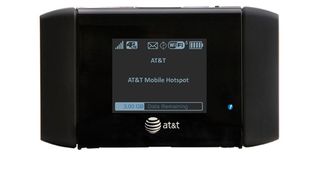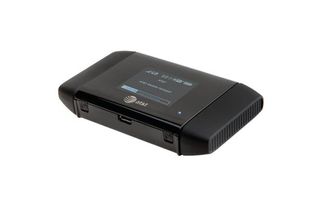Laptop Mag Verdict
AT&T's Elevate 4G provides mobile hotspot consistently fast 4G LTE speeds, a helpful status screen and global connectivity.
Pros
- +
Blazingly fast 4G LTE speeds
- +
Available 32GB microSD card slot
- +
Global connectivity
- +
Informative LCD
Cons
- -
Supports only five device connections at once
- -
Shorter battery life than other hotspots
- -
Coverage limited compared with Verizon
Why you can trust Laptop Mag
If you're looking for a mobile hotspot on AT&T's 4G LTE network, this is it. Literally. At least for now, the AT&T Elevate 4G made by Sierra Wireless is the only device in this category the carrier offers. Back when we originally reviewed this hotspot in the fall of 2011, 4G LTE coverage was limited to nine cities. But the coverage has since expanded to 53 markets. So does the Elevate now live up to its name?
Editor's note: We originally reviewed the Elevate 4G in November 2011, but have recently retested it alongside competing Wi-Fi hotspots. This review and its rating have been updated to reflect those changes.
Design

Click to EnlargeMeasuring 3.8 x 2.2 x 0.7 inches and weighing 3.6 ounces, the Elevate is one of the more pocket-friendly hotspots we've reviewed. On its face, the Elevate features a 1.8-inch color LCD that provides information on the hotspot's signal strength, the data network it's connected to, available SMS messages, the number of connected devices and battery life.
The Elevate's home screen provides users with both the hotspot's SSID information, as well as the total amount of data you've used for the month. On either side of the Elevate's display is a tapered rubber bumper for enhanced grip and a bit of protection for drops or bumps. Along the Elevate's top edge, you'll find its large power button, which is also used to scroll through the hotspot's various menus. Down on the bottom edge are the device's two antenna ports, as well as its microUSB connection.
Pop off the Elevate's battery cover to access its microSD card slot. Unfortunately, removing the cover can be a chore. Taking out the battery is even harder.
4G LTE Coverage
AT&T's 4G LTE network is currently available in 53 markets across the country. That's a huge increase from this time last year, when the carrier covered only nine markets. AT&T says its network should be completely built-out by the end of 2013. If you happen to live in an area not covered by the carrier's LTE network, you should be within one of its HSPA+ coverage areas.
Nevertheless, AT&T still trails Verizon's enormous 4G LTE network, which covers 370 markets. For overseas travelers, the Elevate 4G can also be used in any of the 220 GSM countries where AT&T has roaming agreements. Of course, that will cost you a pretty penny.
Features
The Elevate 4G features a 32GB microSD card slot, Wi-Fi Protected Setup and can receive SMS messages and alerts. The Elevate also features a Web interface that users can access via a URL provided by the hotspot. From there, you can change the Elevate's security and network settings, view your total data usage, check your SMS messages and map your location using the hotspot's built-in GPS.
The Elevate can connect up to five Wi-Fi devices, far fewer than the Verizon Jetpack 4G LTE Mobile Hotspot 890L, which can connect up to 10 devices.
Speedtest.net Performance
We tested the AT&T Elevate 4G in three locations in Manhattan: Madison Square Park, Union Square and Bryant Park. Overall, the Elevate performed the best among other 4G hotspots. Using Speedtest.net, the Elevate's average download rate of 12.4 Mbps across all locations was tops, beating out the second-place hotspot, the Sprint Tri-Fi (using WiMax), by about 3 Mbps. We saw the best speeds in Madison Square Park, where the Elevate averaged 18.9 Mbps. Likewise, the Elevate's average upload speed of 8.3 Mbps crushed the competition. The next fastest hotspot, the Verizon Jetpack, averaged 5.7 Mbps during testing at our New York office.
We then streamed a 720p video to a notebook, and at the same time re-ran the Speedtest.net app on our phone to see the impact of putting stress on the hotspot. While the Elevate's download throughput suffered, dropping to 5.5 Mbps, its upload rate actually increased to 9.7 Mbps. In both tests, the Elevate performed best in Union Square, where downloads averaged 10.8 Mbps, and uploads averaged 12.4 Mbps.
Large File Downloads
Downloading large files was also a breeze for the Elevate. Across the three test sites, it took the hotspot an average of 3 minutes to download the 145MB OpenOffice install file. We recorded the fastest time at Madison Square Park, where it took just 60 seconds. While the Sprint Tri-Fi didn't download the file nearly that fast in any one location, its overall average of 2 minutes and 42 seconds was slightly faster.
Web Surfing
As with our other tests, the Elevate proved generally faster when loading websites. It loaded CNN.com in an average of 5 seconds, beating the Sprint Tri-Fi by 1.5 seconds. NBCNews.com proved a tighter race: The Elevate's time of 5.4 seconds was only 0.4 seconds faster than the Tri-Fi over WiMax. However, Sprint's hotspot finished first when loading Laptopmag.com, taking 7 seconds to the Elevate's 13.1 seconds.
Battery Life
AT&T says the Elevate's 1800 mAh battery is rated for roughly 5 hours of continuous use. During our testing, the unit came in just shy of that mark, lasting 4 hours and 45 minutes while surfing the Web over 4G LTE. That's the shortest battery life in our roundup. The T-Mobile Sonic 4G lasted 10 minutes longer than the Elevate, while the Verizon Jetpack 890L lasted 6 hours and 10 minutes. The Sprint Tri-Fi Hotspot, with its massive 3600 mAh battery, ran for an incredible 10 hours and 35 minutes (over WiMax, not 4G LTE).
Value
AT&T is currently selling the Elevate 4G for $69.99 with a two-year contract. You don't get much choice when it comes to plans, however, since AT&T's only plan is its 5GB for $50 per month. Go over your 5GB allotment and you'll end up paying an extra $10 per gigabyte. Add everything up and the Elevate 4G will cost you $1,269 over two years.
Verdict

Click to EnlargeWith its excellent speeds and reliable connectivity, the AT&T Elevate 4G proved to be the fastest hotspot in our roundup. That said, AT&T's LTE network is still smaller than Verizon's, meaning that some customers will find themselves on the outside looking in. In addition, other hotspots last longer on a charge. Still, if you're looking for top-notch performance, the Elevate 4G is definitely worth picking up.
AT&T Elevate 4G Mobile Hotspot Specs
| Company Website | http://www.att.com |
| Data Connection | EDGE, 4G, LTE, HSPA+, HSDPA, GSM/GPRS |
| Ports | microUSB, External antenna |
| Size | 3.8 x 2.2 x 0.7 inches |
| Supported Protocols | 4G, 3G |
| VPN Support | Yes |
| Weight | 3.6 ounces |
